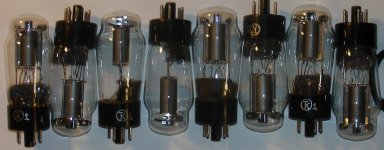Hi, I searched through some threads but did not find a match, apologies if this is a repost. I purchased some tubes at a swap meet that were labeled 6n6c, little yellow boxes, and purported to be be 6V6 tubes. They are smaller than most 6V6 tubes I have seen, and all black. I put them in my 6V6 amp, and they biased right away. Immediately, I was very impressed with the sound, lots of tonanl balance in the mid range and high end, but the lower frequencies were so much better than other 6V6 tubes I have heard, so warm and full. Any insight you folks can offer? I love the sound of these tubes.
Here I am reposting from one of russian forums, about sound signatures of various tubes:Hi, I searched through some threads but did not find a match, apologies if this is a repost. I purchased some tubes at a swap meet that were labeled 6n6c, little yellow boxes, and purported to be be 6V6 tubes. They are smaller than most 6V6 tubes I have seen, and all black. I put them in my 6V6 amp, and they biased right away. Immediately, I was very impressed with the sound, lots of tonanl balance in the mid range and high end, but the lower frequencies were so much better than other 6V6 tubes I have heard, so warm and full. Any insight you folks can offer? I love the sound of these tubes.
" 6P6S tube is very good in sound. In my opinion - one of the best. No wonder that the most famous manufacturers of professional amplifiers (Fender, Rickenbacker, etc.) very often used its analogue 6V6 GT in output stages. When using this tube, you need to remember that due to higher internal plate resistance, you can not get a large output power, but the sound quality forgives this flaw. The power of a SE stage with 6P6S in triode mode is 1.7-2 W, with a very detailed and "full" sound. If you are not accustomed to listening to music at a high volume - apply this tube, it will not disappoint you.
6F6S tibe - in comparison with 6P6S, sounds a bit more transparent at high frequencies. But the difference is barely perceptible. Since the modes of both tubes are almost the same, you can listen to them by simply replacing one with another. In the rest, everything that is said about the 6P6S is also valid for 6F6S. The tube is very linear, very often it is used as a driver for direct heating triodes."
Enclose foto of 6F6S, they have nice cylinder shape plate, and they are better looking (glowing) at operation, than 6P6S.
If somebody is interested, I would offer to swap this 6F6S octet for a pair of good old 6B4G. I need the last 6B4G for comparison with 6S4S (driver position) in my GM-70 amp.
Attachments
Last edited:
6P6S has higher Ua, Ug2, and Wa ratings than 6V6GT. It is roughly equivalent to 7408, the uprated version of 6V6.
Looking at the max plate dissipation values,
6V6GT 12W
6P6S 13W
7408 14W
the 6P6S stands in the middle.
I like them a great deal. Better than most as far as consistency and ruggedness in my experience. They, like any tube, depend on a reasonable quality circuit to work well, but when used correctly they will deliver high quality, low distortion sound with reasonable efficiency, due to the low heater power requirements. They also ROCK when used in AB2! I've got a dozen waiting for a big multi-channel amplifier project.
Member
Joined 2009
Paid Member
Thanks! How much g1 current is needed to drive them in AB2 at around +15 to +20 V?
I would like to correctly dimension the mosfet driver. I planned to supply it with -80 and +30 V and 50 mA, but I haven't found clear information about it.
Are there some suggested g1 and g2 stoppers's values for UL?
I'd start with a value between 470 and 1k Ohm for both, but if there's a more specific datasheet it would be better.
Thanks in advance!
I would like to correctly dimension the mosfet driver. I planned to supply it with -80 and +30 V and 50 mA, but I haven't found clear information about it.
Are there some suggested g1 and g2 stoppers's values for UL?
I'd start with a value between 470 and 1k Ohm for both, but if there's a more specific datasheet it would be better.
Thanks in advance!
I was looking at this document, where they suggest to remove the g2 stopper when converting the amp in UL.
https://www.diyaudio.com/forums/att...ias-ultra-linear-operation-6v6-tubes-1954-pdf
I'd add 270 Ohm at least.
https://www.diyaudio.com/forums/att...ias-ultra-linear-operation-6v6-tubes-1954-pdf
I'd add 270 Ohm at least.
Thanks TG.
I have a custom version of Toroidy 8k Raa trafos used for EL84, but with 23% custom UL taps: TTG-EL84PP - Tube output transformer [8kOhm] 2xEL84 Push-pull or similar - Shop Toroidy.pl
Total Primary DC Resistance: 61,3 Ω
So around 8 Ohm from central to each 23% tap.
Is it enough not to use any current limiter on g2?
Thanks
I have a custom version of Toroidy 8k Raa trafos used for EL84, but with 23% custom UL taps: TTG-EL84PP - Tube output transformer [8kOhm] 2xEL84 Push-pull or similar - Shop Toroidy.pl
Total Primary DC Resistance: 61,3 Ω
So around 8 Ohm from central to each 23% tap.
Is it enough not to use any current limiter on g2?
Thanks
- Home
- Amplifiers
- Tubes / Valves
- Soviet 6V6 tube question

